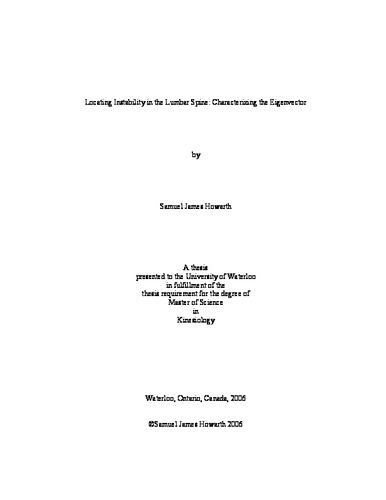| dc.contributor.author | Howarth, Samuel | en |
| dc.date.accessioned | 2007-05-08 13:36:38 (GMT) | |
| dc.date.available | 2007-05-08 13:36:38 (GMT) | |
| dc.date.issued | 2006 | en |
| dc.date.submitted | 2006 | en |
| dc.identifier.uri | http://hdl.handle.net/10012/2808 | |
| dc.description.abstract | Overloading of the back can cause instability such that buttressing the instability is a primary objective of many of the leading edge therapeutic approaches. However, a challenge lies in determining the location of the instability or the least stable vertebral joint. A mathematical analysis, based on a commonly used approach in engineering for determining structural stability, has been developed for the lumbar spine. The purpose of this investigation was to determine the feasibility of a method for mathematically locating potential areas of instability within a computer-based model of the lumbar spine. To validate this method, the eigenvector from the stability analysis was compared to the output from a geometric equation that approximated individual vertebral joint rotational stiffness with the idea that the entry in the eigenvector with the largest absolute value would correspond to the vertebral joint and axis with the lowest stiffness. Validation of the eigenvector was not possible due to computational similarities between the stability analysis and the geometric rotational stiffness method. However, it has been previously demonstrated that the eigenvector can be useful for locating instability, and thus warrants future study. Determining the least stable vertebral joint and axis can be used to guide proper motor pattern training as a clinical intervention. It was also shown in this investigation that an even distribution of fascicle force and stiffness generated stability. This supports the idea that well-coordinated efforts of muscle activation are beneficial for improving stability of the lumbar spine. | en |
| dc.format | application/pdf | en |
| dc.format.extent | 629024 bytes | |
| dc.format.mimetype | application/pdf | |
| dc.language.iso | en | en |
| dc.publisher | University of Waterloo | en |
| dc.rights | Copyright: 2006,
Howarth, Samuel. All rights reserved. | en |
| dc.subject | Kinesiology and Sport | en |
| dc.subject | lumbar spine | en |
| dc.subject | eigenvector | en |
| dc.subject | mechanical stability | en |
| dc.title | Locating Instability in the Lumbar Spine: Characterizing the Eigenvector | en |
| dc.type | Master Thesis | en |
| dc.pending | false | en |
| uws-etd.degree.department | Kinesiology | en |
| uws-etd.degree | Master of Science | en |
| uws.typeOfResource | Text | en |
| uws.peerReviewStatus | Unreviewed | en |
| uws.scholarLevel | Graduate | en |

